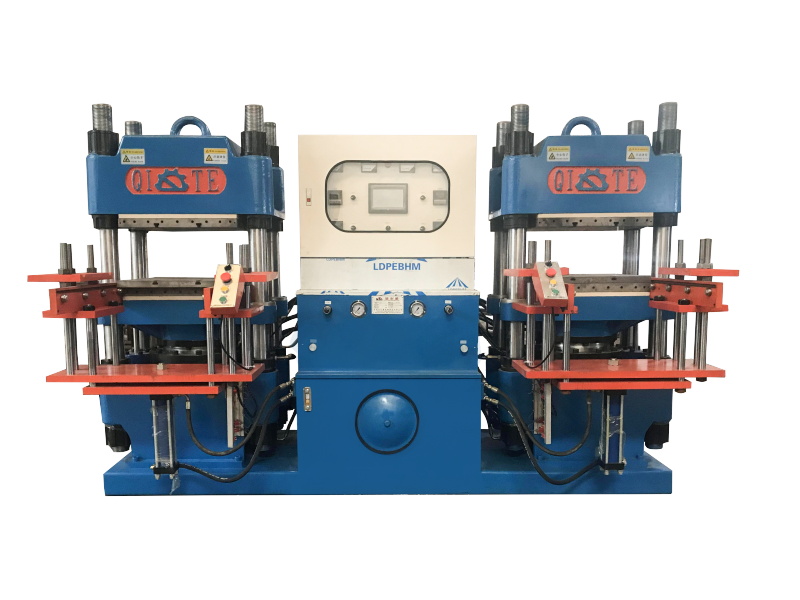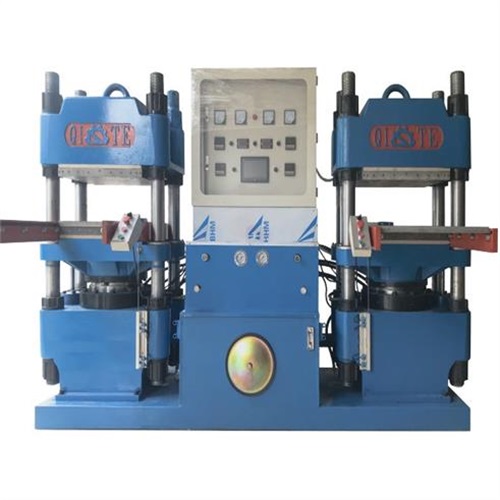
What is a rubber vulcanizing press?
A rubber vulcanizing press is an industrial equipment used for vulcanization and molding of rubber products. It applies high temperature and high pressure to promote chemical cross-linking reaction between rubber and vulcanizing agent, so that the rubber material is transformed from a soft state to a final product with higher elasticity, wear resistance and durability. The core components of the vulcanizer include heating plates, hydraulic systems, molds and control systems to ensure a stable and efficient vulcanization process.

Model | YX-LG200T-2H |
Hot plate specification | 560*560mm |
Hot plate spacing | 250mm |
Cylinder diameter | 350mm |
Machine structure | Four column/single head/double head model |
System pressure | 18MPa |
Heating system | Imported electric heating tube |
Power supply specification | 380V/50HZ |
Essential details | |||
Place of Origin | China | Applicable Industries | Hotels, Machinery Repair Shops, Home Use |
Type | Showroom Location | None | |
Condition | New | Model | YX-LG200T-2H |
Video outgoing-inspection | Provided | Hot plate specification | 560*560mm |
Machinery Test Report | Provided | Hot plate spacing | 250mm |
Warranty of core components | 1 Year | Cylinder diameter | 350mm |
Core Components | PLC | Motor power | 7.5KW |
Voltage | 380V/50HZ | Temperature range | Normal temperature -350°C |
Dimension(L*W*H) | 1.8*3.05*1.95(m) | Working level | Upper and lower layer |
Warranty | 1 Year | Machine structure | Four column/single head/double head model |
Key Selling Points | Automatic | System pressure | 18MPa |
Power (kW) | 22 kW | Power | 380V/50HZ |
Weight (KG) | 6000 KG | ||
Uses of rubber vulcanizing press
Rubber vulcanizing press is widely used in rubber product manufacturing industry and is suitable for producing a variety of rubber products, such as:
Tire manufacturing: used to produce tires for automobiles, motorcycles, bicycles, etc., to improve their wear resistance and pressure resistance.
Rubber seals: including O-rings, oil seals, gaskets, etc., to ensure their oil resistance, heat resistance and corrosion resistance.
Conveyor belts and conveyor belts: The vulcanization process enhances the wear resistance, tear resistance and service life of rubber conveyor belts.
Rubber shock absorbers: used in automobiles, mechanical equipment, etc. to absorb vibration and improve stability.
Rubber soles, rubber pads, etc.: ensure that the product is wear-resistant, non-slip and comfortable.
The vulcanizer ensures that the rubber products have uniform physical properties and improves product quality and durability by precisely controlling temperature, pressure and time.
Heating method of rubber vulcanizing press
The heating method determines the temperature uniformity and energy consumption of the vulcanization process. Common heating methods include:
Electric heating: Directly heat the vulcanized plate through a resistance heater.
High temperature control accuracy, suitable for small equipment and high-precision products.
High energy consumption, suitable for laboratory or small and medium-scale production.
Steam heating:
Provide heat to the inside of the vulcanizer through steam pipes.
The heating speed is fast, suitable for mass production.
But the temperature control is relatively rough, which may affect the consistency of the product.
Thermal oil heating:
Provide stable and uniform heating effect through circulating thermal oil.
The heat distribution is uniform, the energy consumption is low, and it is suitable for high-precision product production.
The initial equipment investment is large, but the long-term operating cost is low.
Different heating methods are suitable for different production needs, and the specific choice depends on product requirements and enterprise production conditions.
Pressure range of rubber vulcanizing press
The pressure range is an important parameter to measure the performance of the vulcanizer, which determines whether the equipment can meet the processing needs of rubber products of different thicknesses and densities.
Small vulcanizer:
Suitable for laboratory and small batch production.
The pressure range is generally 5-50 tons, suitable for thin sheets and small rubber products.
Medium vulcanizer:
Suitable for medium-scale production, such as seals, rubber pads, etc.
The pressure range is generally 50-500 tons, which can be applied to thicker rubber products.
Large vulcanizer:
Applicable to large rubber products such as tires, conveyor belts, etc.
The pressure range can reach more than 1,000 tons, ensuring uniform vulcanization and improving product strength.
Modern vulcanizers usually use hydraulic systems to provide stable pressure, and some high-end equipment is equipped with PLC automatic control systems, which can achieve accurate pressure control of ±0.1 MPa to improve product consistency and qualified rate.
Rubber vulcanizing press is an industrial equipment used for vulcanization of rubber products, which is widely used in the production of rubber products such as tires, seals, conveyor belts, shock absorbers, etc. The heating methods of vulcanizers include electric heating (high precision), steam heating (fast heating), and thermal oil heating (uniform temperature). Different models of vulcanizers provide different pressure ranges, from 5 tons to more than 1,000 tons, to meet the production needs of rubber products of different specifications and thicknesses. Modern vulcanizers are equipped with PLC control systems to ensure that the vulcanization process is accurate and efficient, and improve product quality and durability.
FAQ
What is a rubber vulcanizing press? What is its main purpose?
A rubber vulcanizing press is an industrial equipment used for the vulcanization of rubber products. It promotes the cross-linking reaction of rubber through high temperature and high pressure to improve its wear resistance, elasticity and durability. It is widely used in the manufacture of rubber products such as tires, seals, conveyor belts, gaskets, cable sheaths, etc.
What are the main types of this equipment?
Common types of rubber vulcanizing presses include:
Flat vulcanizer: suitable for all kinds of rubber products, simple structure and strong versatility.
Frame vulcanizer: suitable for smaller products, compact structure and convenient operation.
Column vulcanizer: suitable for large products, uniform force and strong durability.
Automatic vulcanizer: suitable for mass production, equipped with PLC control to improve efficiency and consistency.
What factors need to be considered when choosing a vulcanizer?
Working pressure and tonnage: determine whether the equipment can meet the molding requirements of the product.
Heating method: electric heating, steam heating or thermal oil heating, depending on production needs.
Mold size and number of layers: determine how many products can be produced at a time and increase production capacity.
Automation degree: whether PLC control, automatic mold opening and closing functions, etc. are required to improve efficiency.
What are the heating methods of the vulcanizer? What are the advantages and disadvantages of each?
Electric heating: precise temperature control, suitable for small and medium-sized production, relatively high energy consumption.
Steam heating: fast heating, suitable for mass production, but low temperature control accuracy.
Thermal oil heating: uniform temperature, low energy consumption, suitable for high-precision product production, but large initial investment.
What is the temperature and pressure control accuracy of the vulcanizer?
Modern vulcanizers are usually equipped with PLC control systems, which can achieve:
Temperature accuracy: ±1℃, to ensure uniform rubber vulcanization.
Pressure accuracy: ±0.1MPa, to ensure stable product density and reduce the unqualified rate.
What is the production efficiency of the equipment?
Production efficiency depends on equipment specifications and automation. For example:
Single-layer vulcanizer is suitable for small-batch production, with a vulcanization time of 5-20 minutes.
Multi-layer vulcanizer can vulcanize multiple products at a time to increase production capacity.
Automated vulcanizers reduce manual operations and improve efficiency and consistency.
What are the key points in the maintenance and care of vulcanizers?
Check the hydraulic system regularly to prevent leakage and abnormal pressure.
Clean the heating plate to ensure uniform temperature and improve product quality.
Check the electrical system to prevent PLC and temperature control device failures.
Lubricate key components to reduce wear and extend the life of the equipment.
Can the vulcanizer be customized?
Yes, YUNXIN can customize the equipment according to customer needs, including:
Workbench size, heating method, pressure range, etc. to adapt to different product specifications